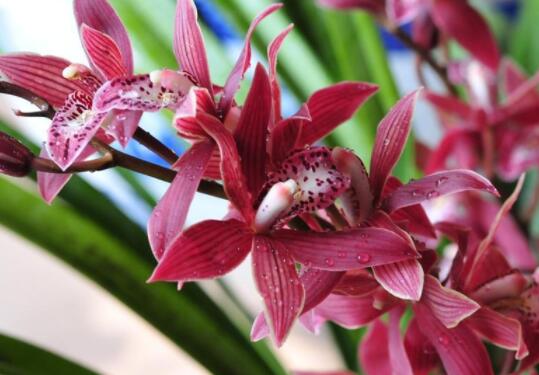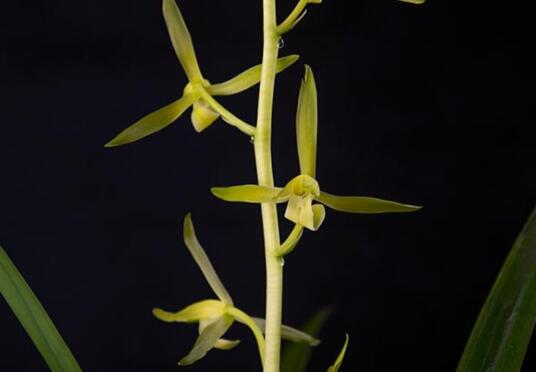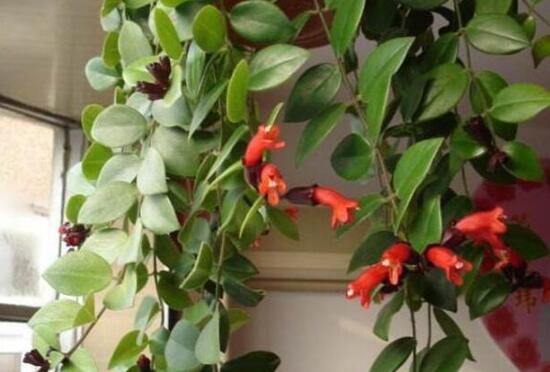How to fertilize and water the orchid, the fertilizer should be light and avoid thick / keep the pot soil semi-dry.
In the process of the growth of the orchid, nutrients are very important to it. Only by maintaining sufficient nutrients can it thrive and produce beautiful flowers. Among its nutrients, fertilizer and water are the most important, so how to fertilize and water the magnolia? Next, the editor will take you to learn about it.
First, how to fertilize the orchids
1. Fertilizer selection

The leaves and roots of this plant are rich in phosphorus, so we don't have to choose fertilizers that contain this element. When choosing fertilizers, we can choose fertilizers that contain nitrogen and potassium. Magnolia has a high demand for these two elements, and this kind of fertilizer can make Magnolia grow stronger.
two。 Fertilization method
Magnolia has a high demand for fertilizer after entering the growing period, so it needs to be fertilized basically every 20 days, and the best temperature for fertilization is about 20 ℃. If it rains, we have to reduce the use of fertilizer.
3. Matters needing attention in fertilization
Before we fertilize the magnolia, we should first dilute the fertilizer with water, which can reduce the concentration of fertilizer, because its fertilization needs are "light and not strong". If we directly apply thick fertilizer to the flowers, it is easy to burn the plants. resulting in yellow and dry leaves, so we should keep this in mind.
Second, how to water the orchids
1. Watering frequency
We usually raise orchids indoors, and the air flows slowly in this environment, so the water will not evaporate very quickly, so we can choose to water once every 10 days, of course, this is only under normal circumstances. If the weather is too hot or cold, then this frequency still needs to be changed, we just need to remember to keep the soil of the orchid in a semi-dry state.
two。 Watering method
Usually we have a habit when watering plants, that is, directly from the top of the plant, in fact, this is wrong, the correct watering method should be along the edge of the flowerpot to pour water to the surface of the soil, let the soil absorb, when we see a small amount of water seeping out from the bottom of the basin, we can stop watering, so that the growth of the orchid will not be affected.
3. Matters needing attention in watering
When watering the magnolia, we must remember to avoid stagnant water in the basin, because it can easily lead to rotten roots, and at the same time, we can't pour water directly from the center of the orchid, which will make the orchid rot. So we must keep this in mind.
Conclusion: after reading the above, I believe you also have a certain understanding of how to fertilize and water the magnolia. In fact, in addition to watering and fertilizing, there are many other areas that need to be paid attention to in the process of breeding it. If you want to raise it well, you can take a look at the culture methods of orchids, in which there are detailed breeding teaching.
How to grow orchids best, how to fertilize orchids and how to water them
Since ancient times, orchids have given us a symbol of nobility and elegance, together with plum, bamboo and chrysanthemum, they are called four gentlemen. The Chinese orchid is very different from the tropical orchid, it has no eye-catching gorgeous state and no huge flowers and leaves, but it has a simple and quiet and elegant and elegant temperament, which is also very in line with the aesthetic standards of the Oriental. So how to raise orchids best, how to fertilize orchids and how to water them?
How to grow orchids best, how to fertilize orchids and how to water them:
Growth habits of orchids:
Orchid it likes the shady environment, and it is afraid of the direct sunlight on it, naturally likes wet taboo and dry, and also likes fertile and humus-rich loam, which is most suitable for growing in a ventilated environment.
How orchids are fertilized and watered:
Fertilization: the newly potted orchid cannot survive if the soil is too fat, and its flowering rate is very small even if it can survive. If too much fat will be too exuberant in autumn, it will also lead to poor flowering in next spring, and too little will affect the formation of flower buds. In fact, the surest way is to see its leaves yellow when it belongs to lack of fertilizer, it should be topdressing for it, and its leaf tip scorch belongs to excessive fertilization, at this time it needs to stop fertilizing for her. Fertilizing for it must use rotten, not mature can not be used, but also taboo on the use of human feces and urine.
Watering: it can be proved by practice that orchids need to be 8% dry and 2% wet, and when it is in flowering and budding, it is less watered. During the rainy season, you should move it indoors or build a rain shelter for it. In summer, you need to water it in the early morning and evening, and you can't water it too much. Watering in autumn can be appropriately increased, if it is a dry season, it needs to be sprayed every evening to make the ground moist and increase the humidity of the air. Watering it can be appropriately reduced in winter, but it cannot be watered without watering. We should be careful not to let the basin soil dry thoroughly. In a word, we should water it when it is dry, and stop watering when it is moist. We should follow the principle of proper partial drying.
Lighting: light is an important factor in the formation of flower buds in many plants. Although the orchid is cool, it will rarely blossom if it is put in a hiding place all the year round. Friends who love orchids have found that the orchid leaves in the shade are long and the flowers are sparse, while the orchid leaves in the sun are short and there are many flowers. Therefore, in the cultivation of orchids, we must pay attention to the problem of lighting. In spring and summer, we'd better shade it with a Reed curtain, or put it in an indoor window that faces east and south. Orchids under the curtain should be turned into pots once every semimonthly, so that orchids are exposed to light on all sides, which is beneficial to the balanced growth of plants. When it is cool in autumn, you should remove the pot orchid from the shade and let it bask in the sun for half a day in the morning, but you should also pay attention to what is not dry in autumn.
How to raise orchids best, how to fertilize orchids and how to water orchids are shared with you here. I hope this article will be helpful to you and wish you good luck.
What about the yellowing of the leaves of orchids? control the amount of water / avoid direct sunlight
Magnolia is a beautiful flower, which has high ornamental value, but no matter how beautiful flowers turn yellow, it will also affect its beauty, so what about the yellowing leaves of magnolia? how to solve it? Next, let's take a look at it.
What if the leaves of Magnolia turn yellow
If you want to know how to do the yellowing of the leaves of orchids, first of all, we have to understand what causes this phenomenon. there are many reasons for this phenomenon, such as improper watering and fertilization, long-term sun exposure, the emergence of diseases and insect pests, and so on. the specific solutions are described in detail below, let's take a look.
1. Improper fertilization
Fertilizer is one of the main nutrients in the growth of magnolia, but fertilization requires skills. If you apply too much fertilizer or apply thick fertilizer directly, it is easy to cause the leaves of the orchid to turn yellow, because the orchid does not need big fertilizer.
Solution: in terms of fertilization, orchids need to apply thin fertilizer skillfully, and do not apply thick fertilizer, large fertilizer and unrotten liquid fertilizer. Before fertilizing, we need to dilute the fertilizer with clean water so that it can be better absorbed.
two。 Improper watering
Although the magnolia likes to grow in a warm environment, it refers to the humidity of the air, not the soil. It likes to dry up a little suddenly. If it is watered too much, it will cause the leaves of the orchid to turn yellow and, in severe cases, cause its roots to rot.
Solution: we must water the magnolia properly, keep the soil in a semi-dry state, normally water once every 10 days, and adjust the watering frequency if the climate change is too great.
3. The light is too bright.
Chinese orchids prefer to grow in a cool environment, but there is no lack of sunlight in the growth process, so they are very particular about lighting. If you put it in direct sunlight to grow, it is easy to cause the leaves of the orchids to turn yellow.
Solution: when we breed the orchid, it is best to put it in a place of sunlight scattering, so that it can carry out photosynthesis without getting sunburned.
4. Diseases and insect pests
In the process of breeding magnolia, if we cultivate it improperly, it is easy to have problems such as diseases and insect pests, which do great harm to the plant, which will not only cause the leaves of the orchid to turn yellow, but also cause the plant to wither and die in serious cases.
Solution: if this problem is caused by diseases and insect pests, we must deal with it in time. The specific treatment methods are introduced in detail in the article "Prevention and Control of Diseases and insect pests of Cymbidium". You can understand it.
5. the new supersedes the old
In the process of the growth of the orchid, with its growth, the new and the old will be replaced, because of the need to develop new leaves, the old leaves will not continue to grow, thus gradually yellowing and falling off.
Solution: if the yellowing of the leaves of Magnolia caused by metabolism, we do not need to worry too much, because this is a normal phenomenon and will not affect the plant.
Conclusion: after reading the above, I believe we all have a certain understanding of the yellowing of the leaves of the orchid. As long as we solve the problem according to the above method, your orchid will certainly get rid of the problem of yellowing.
- Prev

How to raise orchids in winter? pay attention to these five points to help you survive the winter easily.
Winter is a difficult time for most flowers and plants, and it is also the same for orchids, which is not very resistant to cold weather, so we must pay special attention to it when raising it in winter. About how to raise orchids in winter? Next, the editor will take you to learn about it.
- Next

How to raise lipstick orchids, how to raise lipstick orchids and matters needing attention / like astigmatism
For the hanging orchid, we must be no stranger, it is a kind of plant that can absorb formaldehyde. As a beautiful girl in the family, lipstick hanging orchid gets its name because its flowers are shaped like lipstick, which is deeply loved by flower friends. In life, there are many people who want to keep lipstick orchid, so how to keep lipstick orchid?
Related
- Fuxing push coffee new agricultural production and marketing class: lack of small-scale processing plants
- Jujube rice field leisure farm deep ploughing Yilan for five years to create a space for organic food and play
- Nongyu Farm-A trial of organic papaya for brave women with advanced technology
- Four points for attention in the prevention and control of diseases and insect pests of edible fungi
- How to add nutrient solution to Edible Fungi
- Is there any good way to control edible fungus mites?
- Open Inoculation Technology of Edible Fungi
- Is there any clever way to use fertilizer for edible fungus in winter?
- What agents are used to kill the pathogens of edible fungi in the mushroom shed?
- Rapid drying of Edible Fungi

